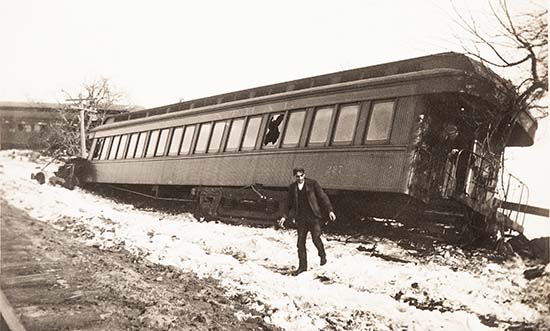 |
 |
| current issue |  | past issues |  | send a letter/news |  | address update |  | advertise |  | about us |  | alumni home |
On Ben's Farm
|
Train Wreck An averted tragedy helped put the university's first gym on track. By Mylinda Woodward '97 |
|
 University Archives |
Machine shop janitor Augustus Stevens was in Hewitt Hall, finishing preparations for the biennial visit of the state Legislature, when he heard it: the high-speed rumble of an approaching train.
The frequent trains that ran through campus usually went unnoticed. But on the morning of January 20, 1905, the sound of the St. John's Express, thundering along the tracks en route from Canada to Boston at almost 50 miles per hour, caused Stevens to glance out the window—just in time to see the last car rocket into the air, pulling three other cars into a stone culvert along with it.
Stevens rushed to the accident site, joined within minutes by what seemed like the entire student body. Under the direction of A. E. Nesbit, a professor in the electrical engineering department, students went to work immediately to help rescue the train's 85 passengers, most of whom were riding in the derailed cars. Some of the students prepared sleighs to transport the most seriously injured to the Durham home of physician Albert Grant or to the Zeta fraternity house, which became a temporary infirmary. Thanks in large part to the swift action of the student rescue crew, even the most seriously injured survived.
Despite the accident, the day's legislative program went forward, with some 150 trustees and state representatives gathering in Morrill Hall to learn more about the state of the young New Hampshire College and the most pressing needs of its students and faculty. One critical issue was the need for a building that would provide facilities for military drills and physical education classes, which were currently being held on the third floor of Thompson Hall.
A new gymnasium had been under consideration since 1894, and in 1903 a committee was finally formed to raise funds for the new building. At the time of the wreck, some two years later, $2,500 had been collected. A few days after the accident, President William Gibbs received a letter from Lucius Tuttle, president of the Boston and Maine Railroad, expressing his gratitude to UNH, and the student body in particular, for its lifesaving assistance. As a tangible display of that gratitude, Tuttle had included a check for $1,000 to go toward student needs.
Grappling with the ethics of accepting payment for the rescue effort, Gibbs held a meeting to which 128 staff members and students showed up. The discussion was heated, with some arguing that to accept a reward would be amoral, while others suggested that refusing the check would come across as an insult. Given the urgent need for new athletics facilities, one student went so far as to say he hoped that if the university rejected the gift, the Legislature would appropriate state funds not for a gymnasium, but for a campus insane asylum, instead.
Ultimately, Gibbs met with Tuttle, who suggested the money be allocated directly to the gymnasium fund. Gibbs accepted, and three months later, the Legislature passed an appropriation bill providing $25,000 for a gymnasium and armory. The new gym, described in The New Hampshire College Monthly as equipped "as well, if not better, than any other like building in the state," was opened in New Hampshire Hall on January 26, 1906—almost exactly a year to the day after the Boston and Maine crash. ~
On November 1, Smith declared the 1944 milkweed collection campaign complete. Vermont had contributed 1,246 bags of pods, and New Hampshire, 12,020. Nationally, more than 1.5 billion pods were collected to produce more than 1.2 million life vests. Mission Milkweed Pod was complete. ~
blog comments powered by Disqus

